A Refractive Index Sensor Based on H-Shaped Photonic Crystal Fibers Coated with Ag-Graphene Layers
Abstract
1. Introduction
2. Structure Design and Simulated Modeling
3. Results
3.1. Birefringence Phenomenon
3.2. RI Sensitivity of the Sensor
3.3. Investigation of Various Structural Parameters
4. Conclusions
Author Contributions
Funding
Conflicts of Interest
References
- Raghunandhan, R.; Chen, L.H.; Long, H.Y.; Leam, L.L.; So, P.L.; Ning, X.; Chan, C.C. Chitosan/PAA based fiber-optic interferometric sensor for heavy metal ions detection. Sens. Actuators B Chem. 2016, 233, 31–38. [Google Scholar] [CrossRef]
- Li, N.; Zhang, D.; Zhang, Q.; Lu, Y.; Jiang, J.; Liu, G.L.; Liu, Q. Combing localized surface plasmon resonance with anodic stripping voltammetry for heavy metal ion detection. Sens. Actuators B Chem. 2016, 231, 349–356. [Google Scholar] [CrossRef]
- Zhao, Y.; Lei, M.; Liu, S.X.; Zhao, Q. Smart Hydrogel-based Optical Fiber SPR Sensor for pH Measurements. Sens. Actuators B Chem. 2018, 261, 226–232. [Google Scholar] [CrossRef]
- Dash, J.N.; Jha, R. On the Performance of Graphene-Based D-Shaped Photonic Crystal Fibre Biosensor Using Surface Plasmon Resonance. Plasmonics 2015, 10, 1123–1131. [Google Scholar] [CrossRef]
- Yu, P.Q.; Chen, X.F.; Yi, Z.; Tang, Y.J.; Yang, H.; Zhou, Z.G.; Duan, T.; Cheng, S.B.; Zhang, J.G.; Yi, Y.G. A numerical research of wideband solar absorber based on refractory metal from visible to near infrared. Opt. Mater. 2019, 97, 109400. [Google Scholar] [CrossRef]
- Wang, Y.Y.; Qin, F.; Yi, Z.; Chen, X.F.; Zhou, Z.G.; Yang, H.; Liao, X.; Tang, Y.J.; Yao, W.T.; Yi, Y.G. Effect of slit width on surface plasmon resonance. Results Phys. 2019, 15, 102711. [Google Scholar] [CrossRef]
- Singh, P. SPR Biosensors: Historical Perspectives and Current Challenges. Sens. Actuators B Chem. 2016, 229, 110–130. [Google Scholar] [CrossRef]
- Lam, W.W.; Chu, L.H.; Wong, C.L.; Zhang, Y.T. A surface plasmon resonance system for the measurement of glucose in aqueous solution. Sens. Actuators B Chem. 2005, 105, 138–143. [Google Scholar] [CrossRef]
- Yang, X.C.; Lu, Y.; Wang, M.T.; Yao, J.Q. An Exposed-Core Grapefruit Fibers Based Surface Plasmon Resonance Sensor. Sensors 2015, 15, 17106–17114. [Google Scholar] [CrossRef]
- Guo, X. Surface plasmon resonance based biosensor technique: A review. J. Biophotonics 2012, 5, 483–501. [Google Scholar] [CrossRef]
- Zhang, M.Z.; Zhu, G.X.; Lu, L.D.; Lou, X.P.; Zhu, L.Q. Refractive index sensor based on ultrafine tapered single-mode nocladding single-mode fiber structure. Opt. Fiber Technol. 2019, 48, 297–302. [Google Scholar] [CrossRef]
- Salihoglu, O.; Balci, S.; Kocabas, C. Plasmon-polaritons on graphene-metal surface and their use in biosensors. Appl. Phys. Lett. 2012, 100, 213110. [Google Scholar] [CrossRef]
- Bunch, J.S.; Van der Zanda, A.M.; Verbridge, S.; Frank, L.W.; Tanenbaum, D.M.; Parpia, J.M.; Craighead, H.D.; Mceuen, P. Electromechanical Resonators from Graphene Sheets. Science 2007, 315, 490–493. [Google Scholar] [CrossRef] [PubMed]
- Dash, J.N.; Jha, R. Graphene-Based Birefringent Photonic Crystal Fiber Sensor Using Surface Plasmon Resonance. IEEE Photonics Technol. Lett. 2014, 26, 1092–1095. [Google Scholar] [CrossRef]
- Wang, L.F.; Ren, K.Y.; Sun, B.; Chen, K.X. Highly Sensitive Refractive Index Sensor Based on Polymer Long-Period Waveguide Grating with Liquid Cladding. Photonic Sens. 2019, 9, 19–24. [Google Scholar] [CrossRef]
- Hassani, A.; Skorobogatiy, M. Design of the Microstructured Optical Fiber-Based Surface Plasmon Resonance Sensors with Enhanced Microfluidics. Opt. Express 2006, 14, 11616–11621. [Google Scholar] [CrossRef]
- Yu, X.; Zhang, Y.; Pan, S.S.; Shum, P.; Yan, M.; Leviatan, Y.H.; Li, C.M. A selectively coated photonic crystal fiber based surface plasmon resonance sensor. J. Opt. 2009, 12, 015005. [Google Scholar] [CrossRef]
- Erdmanis, M.; Viegas, D.C.; Hautakorpi, M.; Novotny, S.; Santos, J.L.; Ludvigsen, H. Comprehensive numerical analysis of a surface–plasmon- resonance sensor based on an H-shaped optical fiber. Opt. Express 2011, 19, 13980–13988. [Google Scholar] [CrossRef]
- Luan, N.N.; Zhao, L.; Lian, Y.D.; Lou, S.Q. A High Refractive Index Plasmonic Sensor Based on D-Shaped Photonic Crystal Fiber with Laterally Accessible Hollow-Core. IEEE Photonics J. 2018, 10, 1–7. [Google Scholar] [CrossRef]
- Rifat, A.A.; Ahmed, R.; Yetisen, A.K.; Butt, H.; Sabouri, A.; Mahdiraji, G.A.; Yun, S.H.; Adikan, F.R.M. Photonic crystal fiber based plasmonic sensors. Sens. Actuators B Chem. 2017, 243, 311–325. [Google Scholar] [CrossRef]
- Brakel, A.V.; Grivas, C.; Petrovich, M.N.; Richardson, D.J. Microchannels machined in microstructured optical fibers by femtosecond laser. Opt. Express 2007, 15, 8731–8736. [Google Scholar] [CrossRef] [PubMed]
- Kostecki, R.; Ebendorff-Heidepriem, H.; Davis, C.; McAdam, G.; Warren-Smith, S.; Monro, T.M. Silica exposed-core microstructured optical fibers. Opt. Mater. Express 2012, 2, 1538–1547. [Google Scholar] [CrossRef]
- Sazio, P.J.A.; Correa, A.A.; Finlayson, C.E.; Hayes, J.R.; Scheidemantel, T.J.; Baril, N.; Jackson, B.R.; Won, D.J.; Zhang, F.; Margine, E.R.; et al. Microstructured optical fibers as high-pressure microfluidic reactors. Science 2006, 311, 1583–1586. [Google Scholar] [CrossRef] [PubMed]
- Li, W.; Chen, B.J.; Meng, C.; Fang, W.; Xiao, Y.; Li, X.Y.; Hu, Z.F.; Xu, Y.X.; Tong, L.M.; Wang, H.Q.; et al. Ultrafast All-Optical Graphene Modulator. Nano Lett. 2014, 14, 955–959. [Google Scholar] [CrossRef]
- Berenger, J.P. A Perfectly Matched Layer for the Absorption of Electromagnetic Waves. J. Comput.Phys. 1994, 114, 185–200. [Google Scholar] [CrossRef]
- Akowuah, E.K.; Gorman, T.; Ademgil, H.; Haxha, S.; Robinson, G.K.; Oliver, J. Numerical Analysis of a Photonic Crystal Fiber for Biosensing Applications. IEEE J. Quantum Electron. 2012, 48, 1403–1410. [Google Scholar] [CrossRef]
- Zakaria, R.; Kam, W.; Ong, Y.S.; Yusoff, S.F.A.Z.; Ahmad, H.; Mohammed, W. Fabrication and simulation studies on D-shaped optical fiber sensor via surface plasmon resonance. J. Mod. Opt. 2017, 64, 1443–1449. [Google Scholar] [CrossRef]
- Yang, X.C.; Lu, Y.; Liu, B.L.; Yao, J.Q. Analysis of Graphene-Based Photonic Crystal Fiber Sensor Using Birefringence and Surface Plasmon Resonance. Plasmonics 2016, 12, 489–496. [Google Scholar] [CrossRef]
- Bing, P.B.; Huang, S.C.; Sui, J.L.; Wang, H.; Wang, Z.Y. Analysis and Improvement of a Dual-Core Photonic Crystal Fiber Sensor. Sensors 2018, 18, 2051. [Google Scholar] [CrossRef]
- Dong, J.L.; Zhang, Y.X.; Wang, Y.J.; Yang, F.; Hu, S.Q.; Chen, Y.F.; Zhu, W.G.; Qiu, W.T.; Guan, H.Y.; Lu, H.H.; et al. Side-polished few-mode fiber based surface plasmon resonance biosensor. Opt. Express 2019, 27, 11348–11360. [Google Scholar] [CrossRef]
- Yang, X.C.; Lu, Y.; Wang, M.T.; Yao, J.Q. SPR Sensor Based on Exposed-Core Grapefruit Fiber with Bimetallic Structure. IEEE Photonics Technol. Lett. 2016, 28, 649–652. [Google Scholar] [CrossRef]
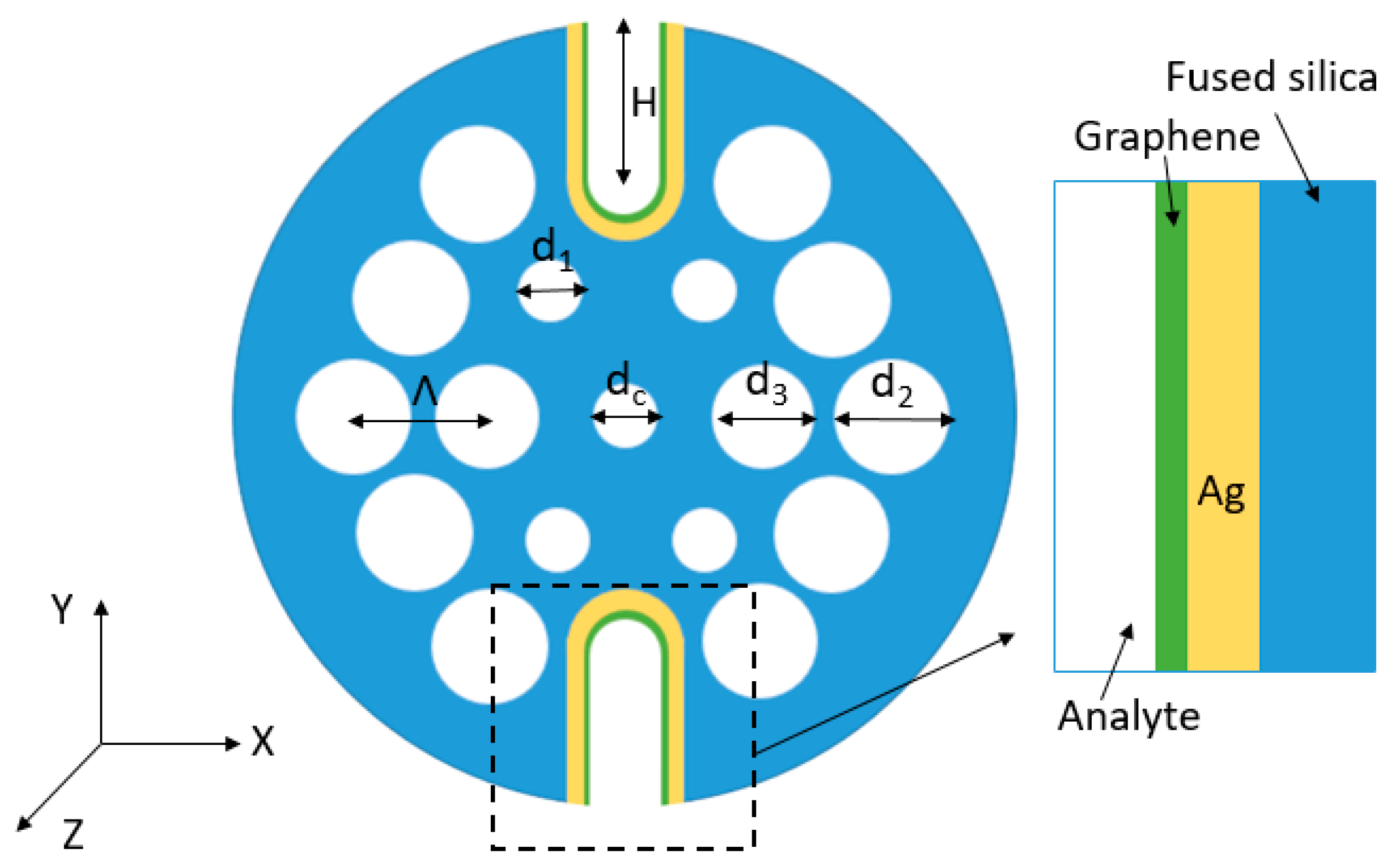


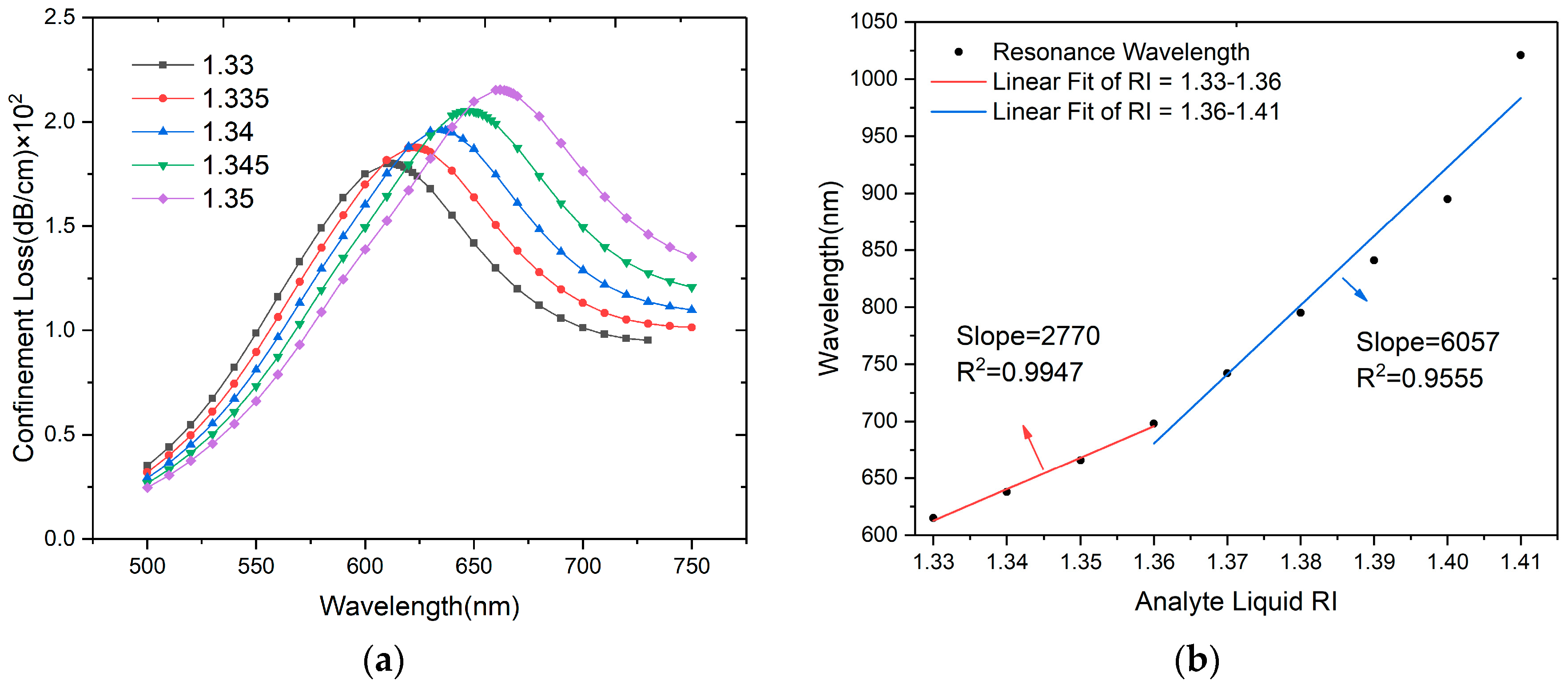
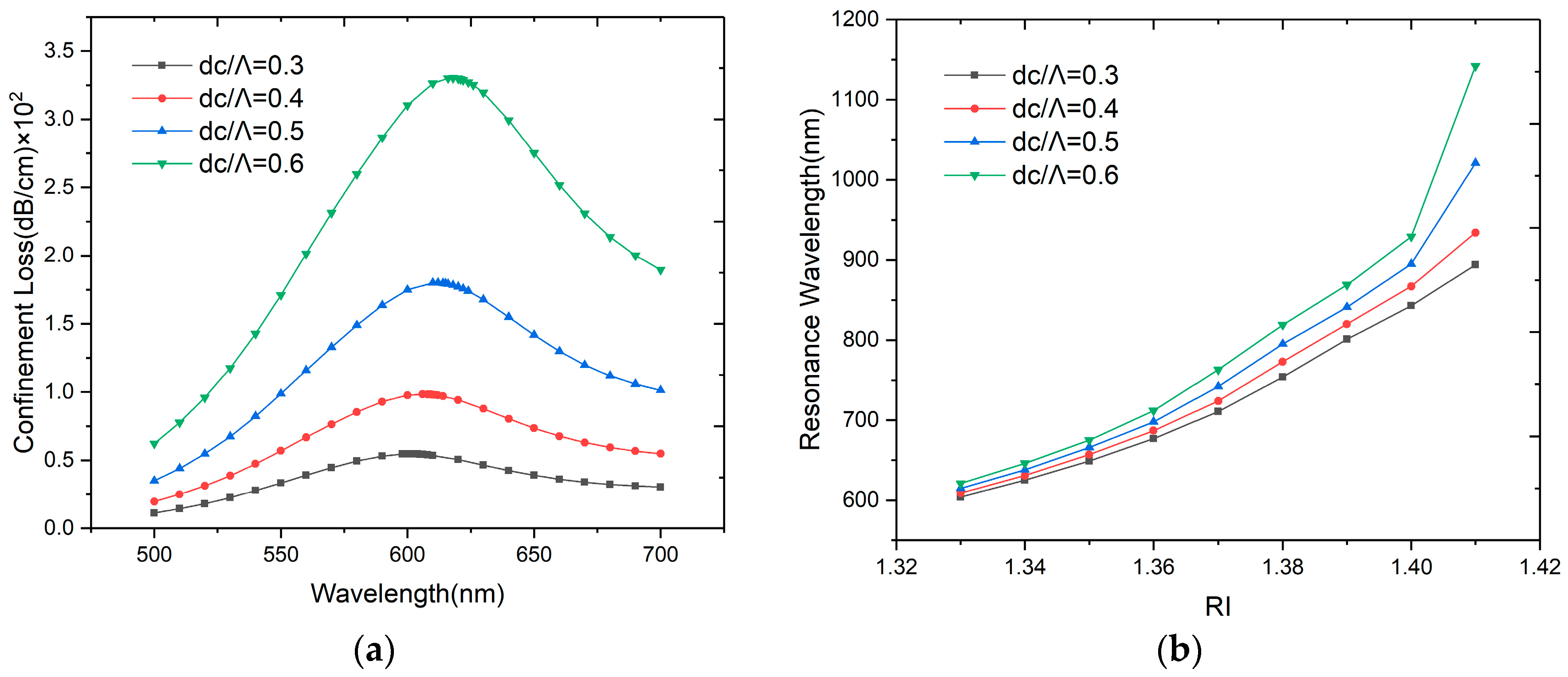
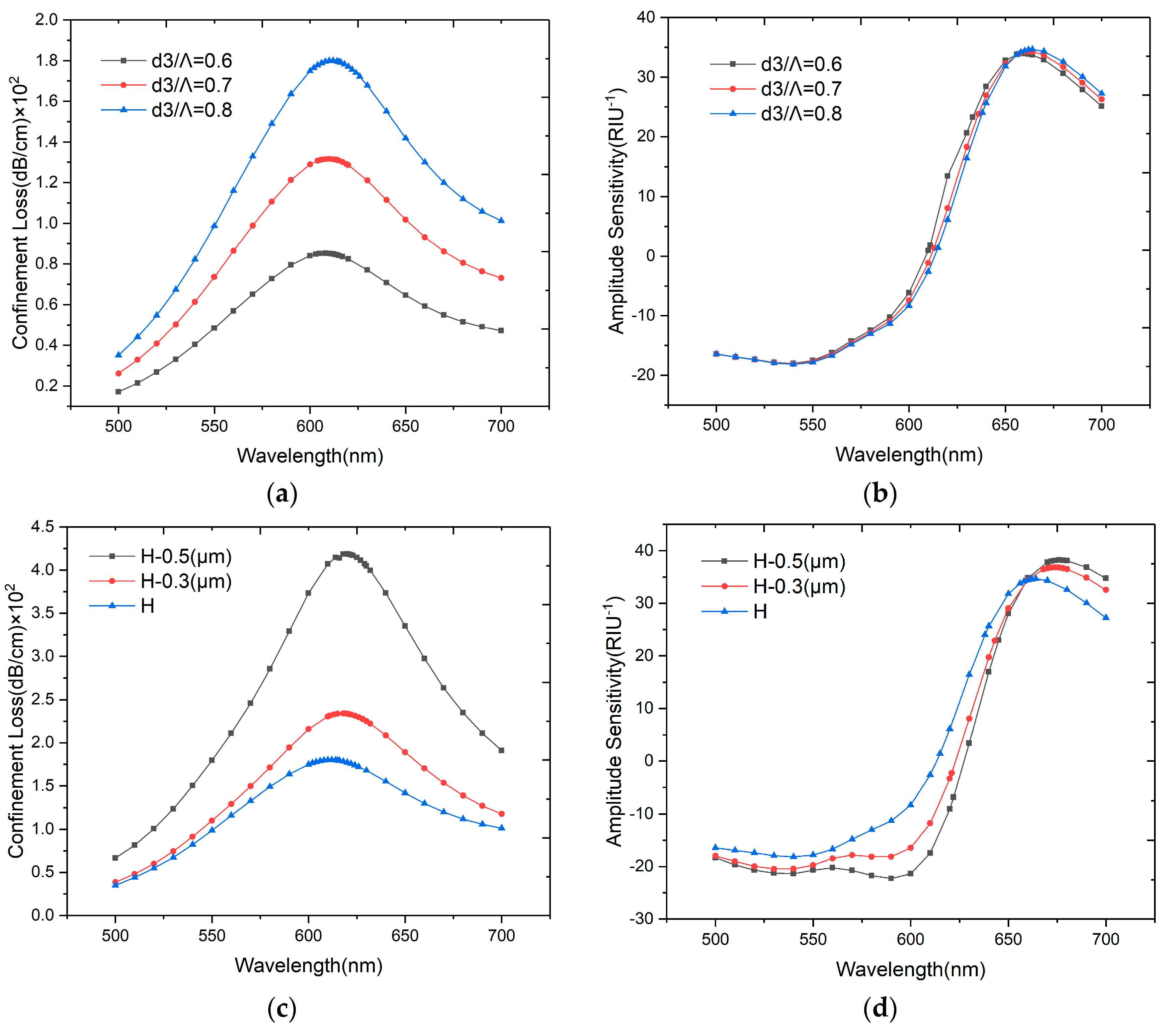
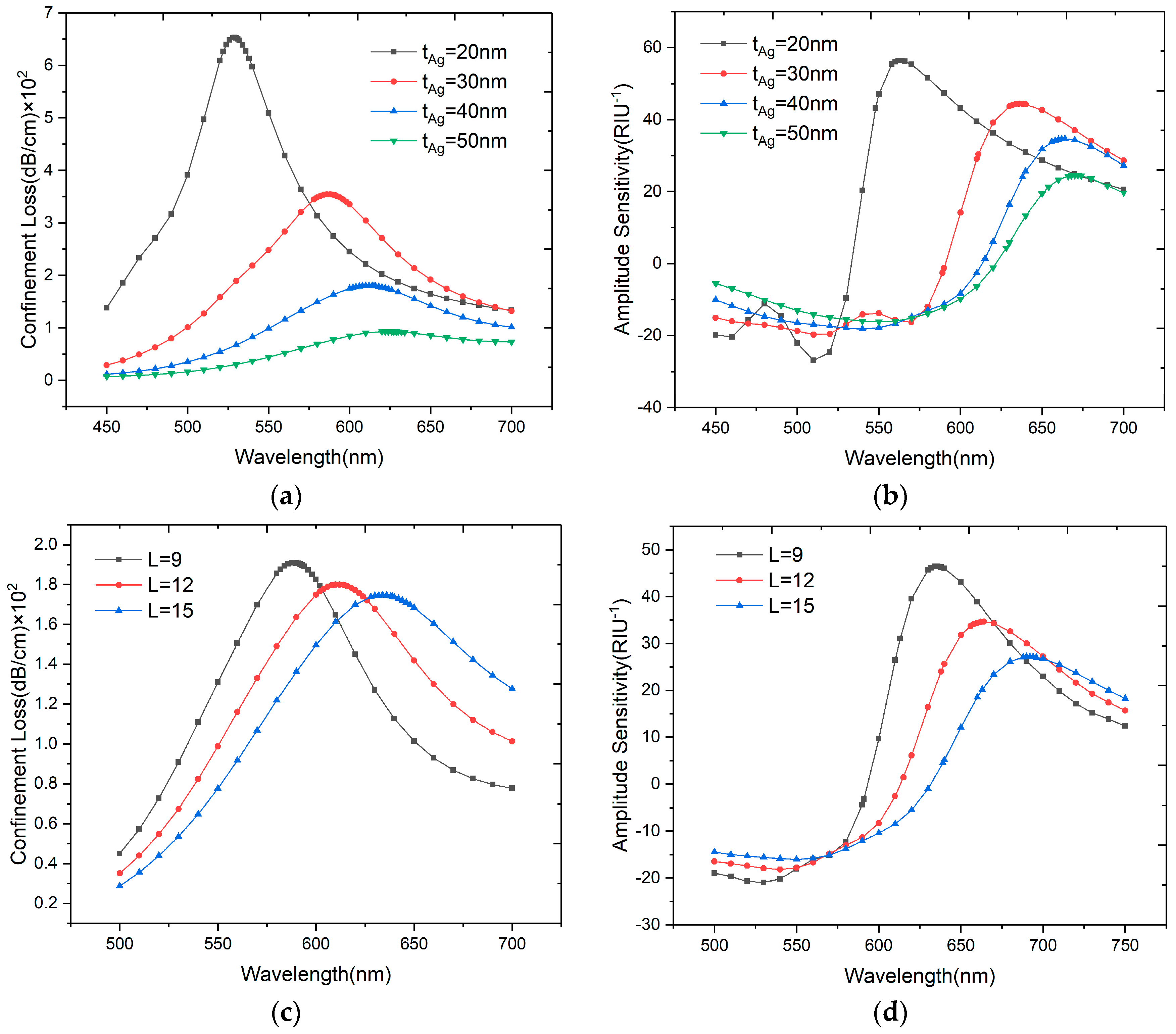
| Characteristics | RI Range (RIU) | Wavelength Sensitivity (nm/RIU) | Resolution (RIU) | Ref. |
|---|---|---|---|---|
| Graphene-Ag coated D-shaped PCF sensor | 1.33–1.37 | 3700 | 2.7 × 10−5 | [4] |
| Exposed-core grapefruit fiber based SPR sensor | 1.33–1.42 | 13500 | 7.41 × 10−6 | [9] |
| Graphene-Ag coated outer surface of PCF | 1.33–1.37 | N/A | 4 × 10−5 | [14] |
| PCF-SPR sensor with enhanced microfluidics | 1.33–1.34 | N/A | ~10−6 | [16] |
| Selectively coated PCF-SPR sensor | 1.33–1.41 | 5500 | 1.82 × 10−5 | [17] |
| SPR sensor based on H-shaped fiber | 1.32–1.33 | 5000 | 2 × 10−5 | [18] |
| Au coated PCF with laterally accessible hollow-core | 1.46–1.47 | 7200 | 1.38 × 10−5 | [19] |
| Graphene-Ag coated PCF sensor | 1.33–1.35 | 2520 | 3.97 × 10−5 | [27] |
| Au coated dual core PCF sensor | 1.33–1.51 | 6021 | 1.66 × 10−5 | [29] |
| Au coated side-polished FMF-SPR | 1.333–1.404 | 4903 | 2.04 × 10−5 | [30] |
| SPR sensor based on exposed-core PCF | 1.33–1.42 | 16400 | 6.1 × 10−6 | [31] |
| This work | 1.33–1.41 | 12600 | 7.94 × 10−6 | N/A |
© 2020 by the authors. Licensee MDPI, Basel, Switzerland. This article is an open access article distributed under the terms and conditions of the Creative Commons Attribution (CC BY) license (http://creativecommons.org/licenses/by/4.0/).
Share and Cite
Li, T.; Zhu, L.; Yang, X.; Lou, X.; Yu, L. A Refractive Index Sensor Based on H-Shaped Photonic Crystal Fibers Coated with Ag-Graphene Layers. Sensors 2020, 20, 741. https://doi.org/10.3390/s20030741
Li T, Zhu L, Yang X, Lou X, Yu L. A Refractive Index Sensor Based on H-Shaped Photonic Crystal Fibers Coated with Ag-Graphene Layers. Sensors. 2020; 20(3):741. https://doi.org/10.3390/s20030741
Chicago/Turabian StyleLi, Tianshu, Lianqing Zhu, Xianchao Yang, Xiaoping Lou, and Liandong Yu. 2020. "A Refractive Index Sensor Based on H-Shaped Photonic Crystal Fibers Coated with Ag-Graphene Layers" Sensors 20, no. 3: 741. https://doi.org/10.3390/s20030741
APA StyleLi, T., Zhu, L., Yang, X., Lou, X., & Yu, L. (2020). A Refractive Index Sensor Based on H-Shaped Photonic Crystal Fibers Coated with Ag-Graphene Layers. Sensors, 20(3), 741. https://doi.org/10.3390/s20030741




